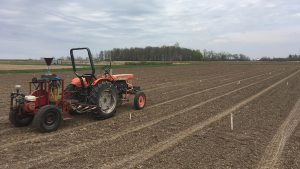Field observations
FALL 2020 UPDATES
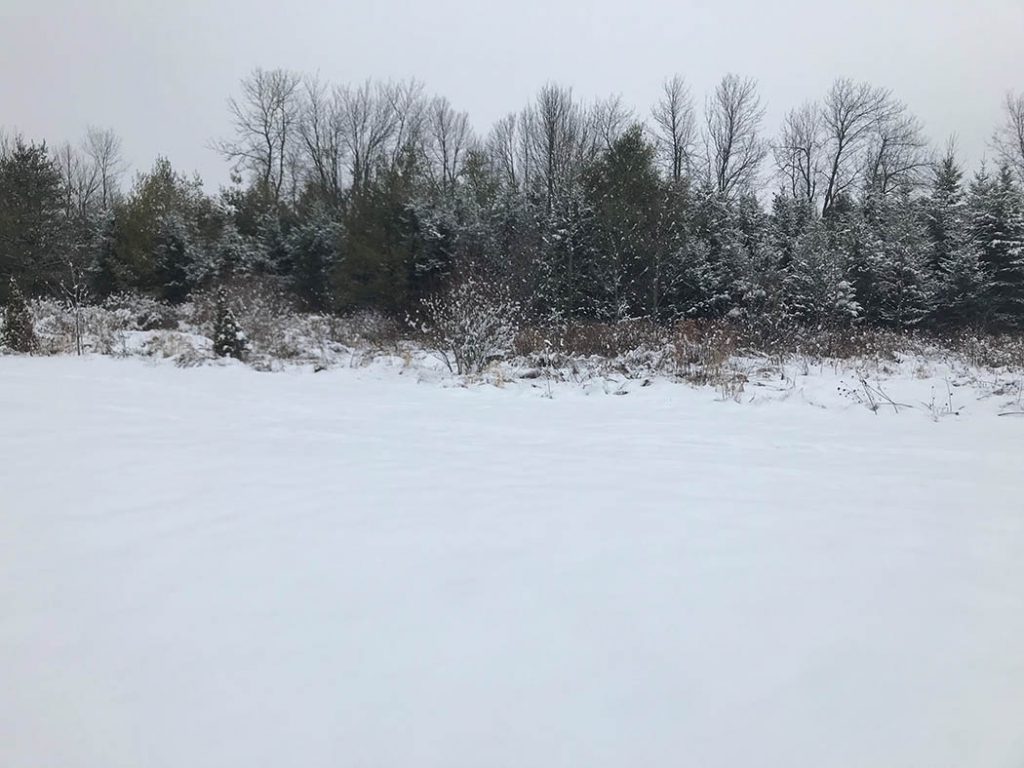
November 27, 2020
With less than a month until Christmas, the 2020 harvest is approaching complete. It has been a much more pleasant harvest than in past years, with cooperative weather for most regions.
Corn
Many areas saw another snowfall this past week, with the Guelph area receiving 20 centimeters in about 13 hours. Harvest is almost completely wrapped up across Ontario. It has been an incredible harvest with good yields, dry corn, and good prices. It’s always nice to be done most of the acres prior to any major snow accumulation. There is still some corn standing in the snow, it will remain until conditions allow for harvest to continue.
The 2020 Ontario Corn Committee trial results have been released and can be found here www.gocorn.net/v2006/CornReports/2020cornreport/2020performancetrials.html
Lockdowns and public health restrictions vary across the province as the COVID-19 pandemic continues. A gentle reminder to call or email your seed dealers instead of meeting with them directly, if possible. This will reduce the risk of virus transmission amongst family and friends.
Soybeans
The Ontario Soybean and Canola Committee has released additional performance tables from the 2020 Ontario Soybean Variety Trials. The Early MG2 and Late MG2 maturity groups are now available along with the previously released 2020 MG00E, MG00, and MG0 maturity groups. This information can be found on the agronomic performance page at www.gosoy.ca/performance.php.
Cereals
According to recently released Agricorp numbers, as of November 19, 73,611 acres of spring wheat was insured for the 2020 growing season. An average yield of 47 bu/ac, weighted average farm yield of 57 bu/ac, and 83 per cent of the average farm yield was reported.
Oats, as of November 18, 2020, there were 41,425 acres insured for the 2020 year, with an average yield of 87 bu/ac (2,779 lb/ac), weighted average farm yield of 90 bu/ac (2,894 lb/ac) and 96 per cent actual yield percentage of the average farm yield.
Barley, as of November 18, 2020, there were 35,311 acres insured for the 2020 year, with an average yield of 60 bu/ac (2,882 lb/ac), weighted average farm yield of 63 bu/ac (3,010 lb/ac), and 96 per cent actual yield percentage of the average farm yield.
Research
Grain Farmers of Ontario has more than 200 funded research projects listed online. One of the current projects that is being supported is the “Winter Wheat Nutrient Uptake, Partitioning and Removal” by Peter Johnson. The understanding of nutrient demand and uptake timings of high yield wheat will give farmers the opportunity to fine tune fertility applications, supporting even higher yields to maintain profitability and keep wheat as a viable option in crop rotations. For more information on this project, or others, visit https://gfo.ca/research/research-project-summaries/
Do you have a picture to share with us from your harvest? Email lferrier@gfo.ca.
November 20, 2020
Winter has blown in with rain, wind, freezing rain, and snow. Fortunately, harvest is wrapping up in most areas of the province. Some harvest continued this week on the remaining acres of corn, but with a little more difficulty as record-breaking strong winds have snapped corn stalks as if they were toothpicks.
Corn
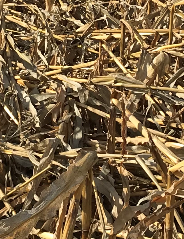
Many farmers that had n their corn out of the field and in the bin by last weekend where thankful they had the nice 10 day stretch in early November to finish harvest. If you still have corn out in the field, no need to do the push test to check standability, the winds last Sunday tested it for you. Record wind speeds occurred across the province on Sunday with St. Catharines clocking in at 141 km/hr. Most of southern Ontario had many stories to tell of the damage experienced. Many weak trees were tested, and some didn’t stand up to the heavy winds experienced on Sunday, resulting in numerous power outages across Ontario.
There are some reports of corn being harder to dry and slower to dry than usual. There may be a few reasons why, but one indicator is the high test weight corn many farmers have been reporting. With higher test weight comes denser grain with tighter packed starch, or more the opaque starch, which makes it harder for moisture migration through the kernel as there is less air space in the kernel.
Test weights can be impacted by several factors of environmental conditions interacting with genetics. These include physical characteristics of the kernel such as size, shape, and starch type and management conditions such as planting date, harvest date, moisture at harvest, fertility, and disease protection. Plant stress such as disease, insects, low soil fertility, and environmental conditions such as heat, cold, or drought can also slow the corn factory down and reduce the amount of carbohydrates produced by the plant.
Reduction in photosynthesis of the plant reduces the production and assimilation of sugars into the kernel and results in decreased test weight. This year has seen some ideal growing conditions with a bit drier weather early in the season with less disease development, and ideal rains later in the season providing ideal conditions for healthy corn plants. Plants were able to produce and pack the largest amount of starch into the kernels that we have seen in a few years.
Seed sales season is in full swing. The best discounts and selection of the best hybrids are now. The reason it is important to get some seed on the books is so the right hybrids will be at your dealer’s location or in your shed for spring. As your needs may be different than last year, you should ensure you work on your seed selection plan and take in the three key factors of your seed selection to make sure you plan what you need to plant next spring.
Seed Selection Criteria
- Agronomic package – maturity, disease tolerance, match genetics to your management and your needs., Consider test weight, dry down, husk cover, plant height, pollination timing.
- Right insect traits – use the traits for your needs and field conditions, don’t use the wrong traits if you have insect resistance issues such as Corn Rootworm. Create an insect resistance plan on your farm. See Field Crop News for more detail https://fieldcropnews.com/2020/10/mitigation-measures-for-bt-resistant-corn-rootworm/
- Consider the end in mind – who you sell your grain to is your customer, make sure you find out what your customer’s needs are, ask what kind of product they are looking for, or what they do not allow. It may be traits that are not approved or they may need specific quality parameters such as low DON levels, or a specific test weight. Knowing your market today helps you plan your crop for next year
Remember when choosing hybrids, don’t pick hybrids based on any one season or one location. Look at multiyear evaluations across different environments and compare to products you know. The Ontario Corn Committee (OCC) trial results will be published soon at http://www.gocorn.net/. The trial data includes head to head comparisons of hybrids which can be viewed using the Hybrid Comparison Selector on the OCC website.
Remember to select a package of hybrids that you are comfortable with, have experience with, and know how to manage. Growing a package of hybrids spreads your risk by spreading out the pollination period and diversifies your investment.
Soybeans
Soybean harvest is also mostly wrapped up across the province. Most of the province harvested exceptional yields.
When choosing soybean varieties for the next year, be aware of what varieties have done well on your farm, and in the area, and remember to look at multi-year trials not just one season. The Ontario Soybean and Canola Council (OSACC) is releasing data as it is being finalized. The early maturity trial (Table 2 and 3) data is now available. By Nov 24, 2020 the remaining trials for the fuller season (Table 4, 5, and 6 )will be available. Make sure you check the year at the top of the trial title as it will indicate which year the trial is from. Results from previous years can be found here, along with head to head comparisons. https://www.gosoy.ca/performance.php Remember that early order and early pay discounts from seed suppliers are approaching quickly, take advantage of these if you can.
Wheat
A reminder that the Agricorp deadline to report acres for fall-seeded crops is November 23, 2020.
Field Work
Have you ever thought of trying something a bit different? Many farmers have been asking questions about strip-tillage, they have read about it, talked about it, but still have many questions. Well, you are in luck, there is a Strip-Till Speaker Series over three evenings in December. Make sure you check it out.
Strip-Till Speaker Series
Hear from experienced and innovative Ontario strip-till farmers!
Presented by the OMAFRA Soil Team
- Tuesday, December 8th, 7-8pm – Timing & Tools: Shank vs. Coulter and Spring vs. Fall
- Thursday, December 10th, 7-8pm – Strip-Till and Cover Crops: How Do They Work Together?
- Tuesday, December 15th, 7-8pm – Strip-Till and Soil Fertility: Fertilizer and Manure Application
Research
Grain Farmers of Ontario has more than 200 funded research projects listed online. One of the current projects that is being supported is the “Long-term cover crop experiment: How much difference do cover crops make?” by Laura Van Eerd. While many research questions can be addressed with short term projects, there is a need to evaluate the impact of long-term cover cropping. Knowing the long-term impact (positive or negative) of cover crops on the following crop yield and resiliency over the years may assist farmers’ management decisions when choosing cover crop practices that maintain crop yield, enhance ecosystem services, and drive competitiveness For more information on this project, or to see others, visit https://gfo.ca/research/research-project-summaries/
Do you have a picture to share with us from your harvest? Email lferrier@gfo.ca.
November 13, 2020
A warm, dry stretch of sunny weather has created a 10-day window that has accelerated harvest for corn and allowed most of the remaining soybeans to be harvested. Wheat has also benefitted from the warmth with advancement in growth and the addition of tillers on earlier planted fields.
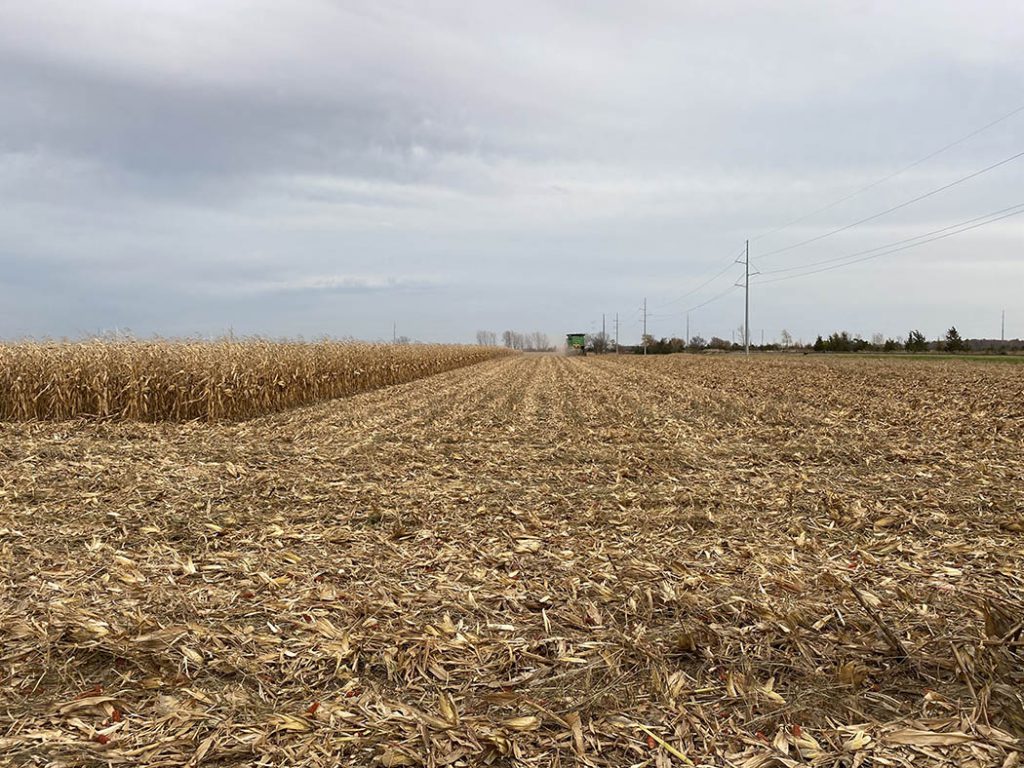
Corn
A beautiful stretch of fall weather arrived in November. It created a great opportunity to harvest many acres in a few days. Grain corn dry down has been faster the last two weeks than it has all fall, some farmers were able to see nearly a one per cent drop in moisture per day, when usually the average is three days per point of moisture in an average fall. Warmer temperatures and a light breeze make all the difference. Drier conditions have also led to fewer break downs and less frustration on the farm. It is great to have an opportunity when you are not chased by the weather and can just work at manageable speeds that allow for safety for operators and equipment alike. Taking time to rest and refuel during the busy time sure makes it more enjoyable. Farmers across the province are 50 % -100% completed on corn harvest.
Grain Farmers of Ontario has created a webinar on grain bin safety, featuring Dean Anderson of Workplace Safety & Preveniton Services (WSPS). Anderson includes some extremely valuable tips on bin safety and bin rescue. Everyone who handles grain should watch this webinar as a valuable addition or reminder to your knowledge.
Soybeans
The stretch of nice weather has allowed soybean harvest to move closer to completion. Most farmers have wrapped up soybean harvest and have moved to full on corn harvest.
Wheat
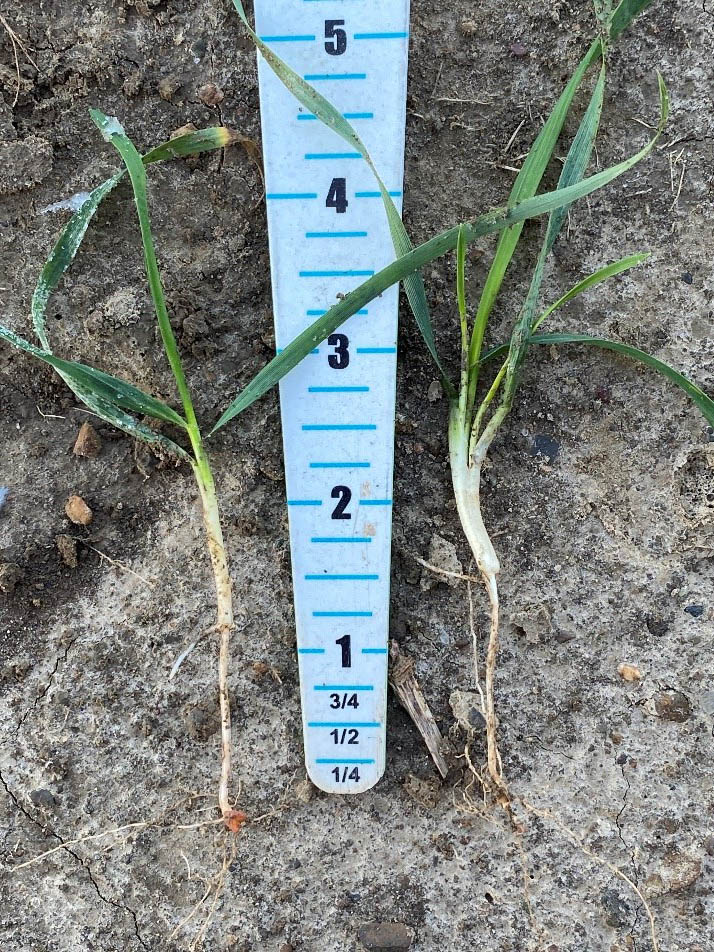
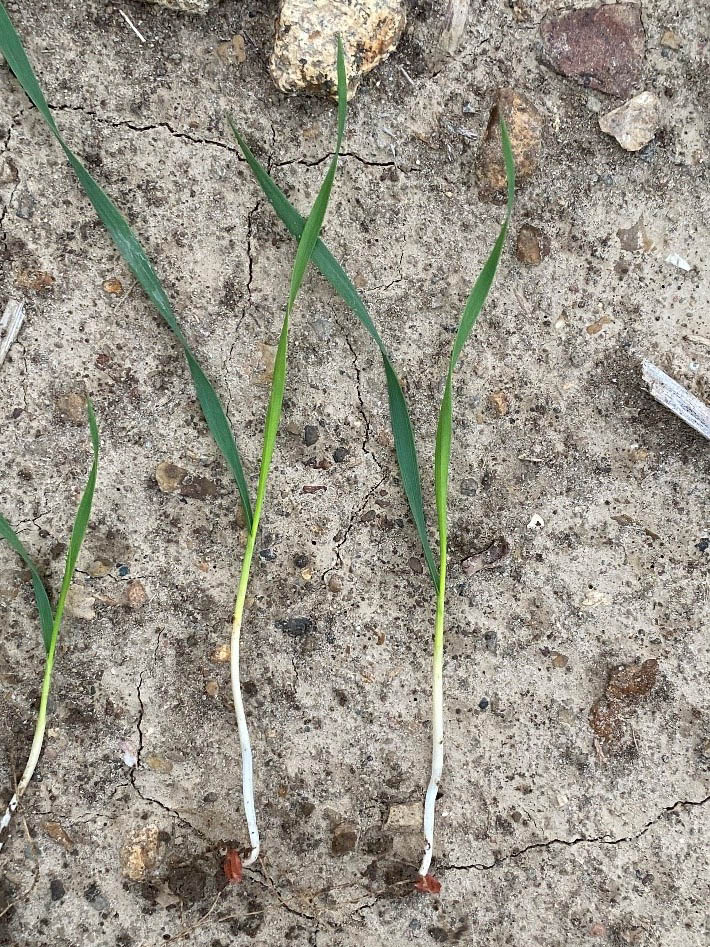
Wheat plants have benefitted from the warm stretch, allowing later planted fields to establish plants to a more ideal crop stage before winter sets in. The wheat pictures show plants from a field planted at the end of September. In the last four weeks the crop has advanced from the two leaf stage (GS12) to the four leaf and two tiller stage (GS22). This will set the crop up for great potential in the spring as tillers have already started to form. These plants have deep roots as the planting depth was two inches as seen by measuring the seed and length of roots. The nodal roots are positioned ¾ inch below surface and the measure of the mesocotyl (seed to nodal root) of 1 ¼ inch puts the seed at a two-inch placement. The continued development of the roots this fall will ensure the seedling is well rooted and will not be subject to excessive heaving in the spring.
Populations of wheat stands are very strong this fall. As we had a dry grain fill period on the wheat crop this past June, the wheat seed was smaller this year. Farmers that have not adjusted seeding rate to compensate for the smaller seed size may be looking at some very thick stands. High seeding rates and early planting can lead to lots of potential if managed properly. For these fields make sure you assess your stands and start planning to intensify your management. Applications of nitrogen and sulfur to feed the plants and applications of fungicide to keep the dense canopy disease free will be of best benefit for maximum yields and profitability. Diseased and malnourished plants will rob profit from the farm. Stay on top of the fields and manage them even more intensely this coming spring.
Field Work
We have seen many harvests in the past few years with a lot of mud on the tires. This has caused damage to the soil through compaction. This fall is allowing farmers to have a great start to next year by applying some remedial tillage to fix compacted soil. The drier soil conditions are allowing farmers to fix the problem of the past few years with soil fracturing during these ideal conditions. Using the proper tools farmers can break the compaction barrier if they are not using cover crops to do the work for them. There have been some sightings of “recreational tillage” across the countryside as farmers may be thinking it is spring, not fall. Farmers certainly are not used to sitting idle on nice days and the temptation of doing extra field work and preparing the soil for the spring while the sun is shining, and the soil is fit is strong. Remembering to keep some residue on top of the soil will help reduce soil erosion losses. Don’t be led astray by the sun’s tempting call, maintain your soil stewardship program in the effort to keep the soil in place for next year.
Research
Grain Farmers of Ontario has more than 200 funded research projects listed online. One of the past projects that has been supported is the “Disease study group: focus on new and emerging soybean diseases” by Albert Tenuta of the Ontario Ministry of Agriculture, Food and Rural Affairs (OMAFRA) and Kiersten Wise of Purdue University. The ultimate outcome is that industry personnel and soybean farmers will have an improved awareness of emerging diseases. There are diseases that are an annual threat, such as sudden death syndrome (SDS) and soybean cyst nematode (SCN) but many other diseases are sporadic, new, or emerging in Ontario. This information will prevent soybean yield losses by identifying and managing present and future disease issues. For more information on this project or to see others click here.
November 6, 2020
November is here! Snow arrived across parts of the province this past weekend, but was quickly replaced by sunny skies. Corn harvest continues with this stretch of warm weather. The lower humidity and some wind has created drier conditions this week. This has helped farmers get back to harvest and finish the remaining soybean fields and allowed the corn to start drying down as harvest in corn progresses.
Corn
Corn harvest has picked up the pace this week as harvest conditions have improved. The week opened with snow in many areas of the province but by mid-week, with above normal temperatures, and sunny skies, harvest was in full swing. It has been reported that corn moisture levels have not dropped in October like one would expect. This is due to the cool, wet weather in October which limited any drying opportunities. High humidity conditions in October did not lead to any drying opportunities in the field but had brought on some continued crop deterioration as fungal development thrived in the cool damp conditions. Reports of mould development are springing up. Growers are encouraged to walk fields and assess for possible problem fields and harvest them before they become more problematic due to stalk or cob rot. Moisture levels have dropped this week with many samples in the lower 20s range which is much better than the high 20s and into the 30s the last few weeks.
Yields reported have been very good in areas that received timely rains. It is estimated that yields will be above average this year. The 10-year provincial average is 170 bu/ac according to Agricorp in 2019.
Soybeans
Harvesting of soybeans when the ground is saturated can cause conditions where soybeans can be mud tagged. According the Canadian Grain Commission, a soybean that is completely covered with caked on mud is considered damaged.
Favourable weather this week has led to some good harvest conditions for soybeans and many of the remaining fields have been able to be combined.

Wheat
Winter wheat continues to grow. As temperatures begin to drop, winter wheat begins to acclimate to the cold. Certain genes within the wheat produce a substance that protects the cell membranes. In a wheat plant that has developed a minimum of four to five leaves and one to two tillers, cold acclimation begins when soil temperatures at the crown go below 10° C. If the plant is not at this stage, the lack of tillers heading into winter can result in an inadequate number of heads the following year, affecting yield. Tillers can still develop in the spring, but the yield potential may differ between tillers formed in the fall and tillers formed in the spring. It takes approximately four to six weeks with soil temperatures below 10° C at the crown depth for the wheat plant to fully harden. The colder the soil, the more quickly the plants develop winter hardiness. The fluctuating air temperatures that we are seeing also influence soil temperature to a point. Once the cold acclimation begins in the fall, wheat plants can unharden when soil temperatures at the crown go above 10° C and will re-harden when the soil at the crown goes below 10° C.
Do you have a picture of harvest that you would like to share for our newsletter? Email lferrier@gfo.ca with it!
Research
Grain Farmers of Ontario has more than 200 funded research projects listed online. One of the current projects that is being supported is “Integrated Weed Management strategies for the control of glyphosate-resistant waterhemp” by Peter Sikkema. In this project Sikkema is aiming to develop an Integrated Weed Management (IWM) strategy that will provide near perfect glyphosate-resistant waterhemp control by depleting the seedbank. As a result of this research, Ontario grain farmers will have data from local studies on the effectiveness of many of the principles of IWM that could lead to the development of long-term, sustainable weed management strategies for control of waterhemp in a corn- soybean-wheat rotation.
To learn more about this project, or to view other project summaries on topics ranging from cover crops, precision ag, management, genetics and many more, visit our research page.
October 30, 2020
Corn harvest is progressing despite some slowdowns from scattered showers and snowfall in some areas of the province. The remaining few soybeans fields are looking for a few dry days before they can be harvested.
Corn
Corn harvest is approaching 50 per cent complete in some areas of the province. More typically though, harvest is 20 – 30 per cent complete, with moisture levels around the mid-20s. Cooler weather and rain and/or snow is causing harvest to stretch out with grain remaining up in moisture.
In eastern Ontario, less than 10 per cent of the crop is harvested, with yields being lower than anticipated. Eastern Ontario had a lack of rain during June and July which affected grain production from the Kingston area east. Yields in the eastern part of the province range from 80 to 170 bushels per acre (bu//ac), with the average being around the 120 to 140 bu/ac. Test weights are higher than 2019, but still less than desired, due to limited rainfall. Some farmers are experiencing the second year in a row for lower corn yields and quality.
Soybeans
Soybean harvest is more than 90 per cent complete across the province, some areas are still struggling to complete harvest due to on and off rain showers and snowfall making for saturated ground conditions. Areas in Eastern Ontario have had good yields but are also struggling with the final stretch of harvest.
If harvest is not going how you planned, Grain Farmers of Ontario, along with several other organizations, have resources on managing stress. https://ontariograinfarmer.ca/2020/10/01/harvest-stress/
Wheat
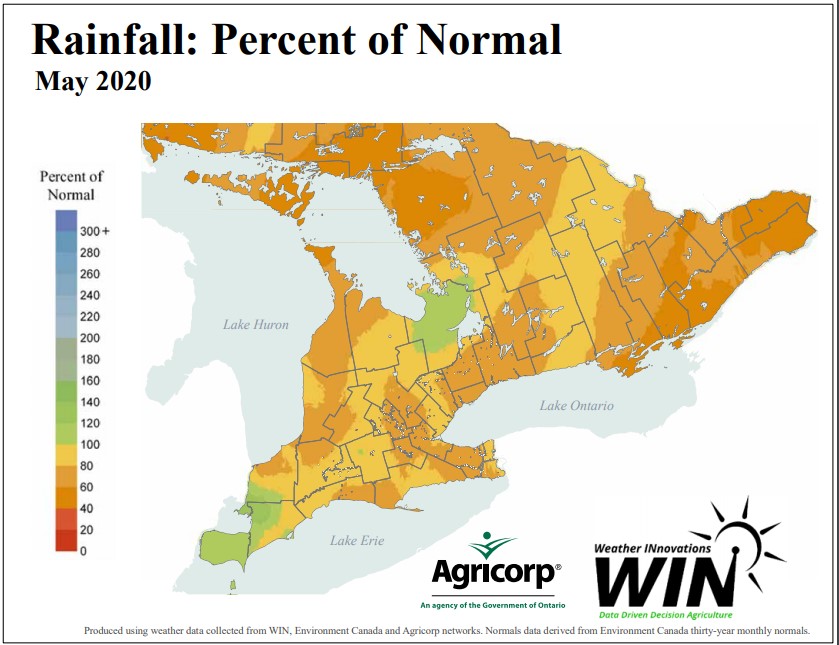
Early planted wheat is at the Z21 growth stage. Cool, damp weather has been ideal for wheat growth in most areas.
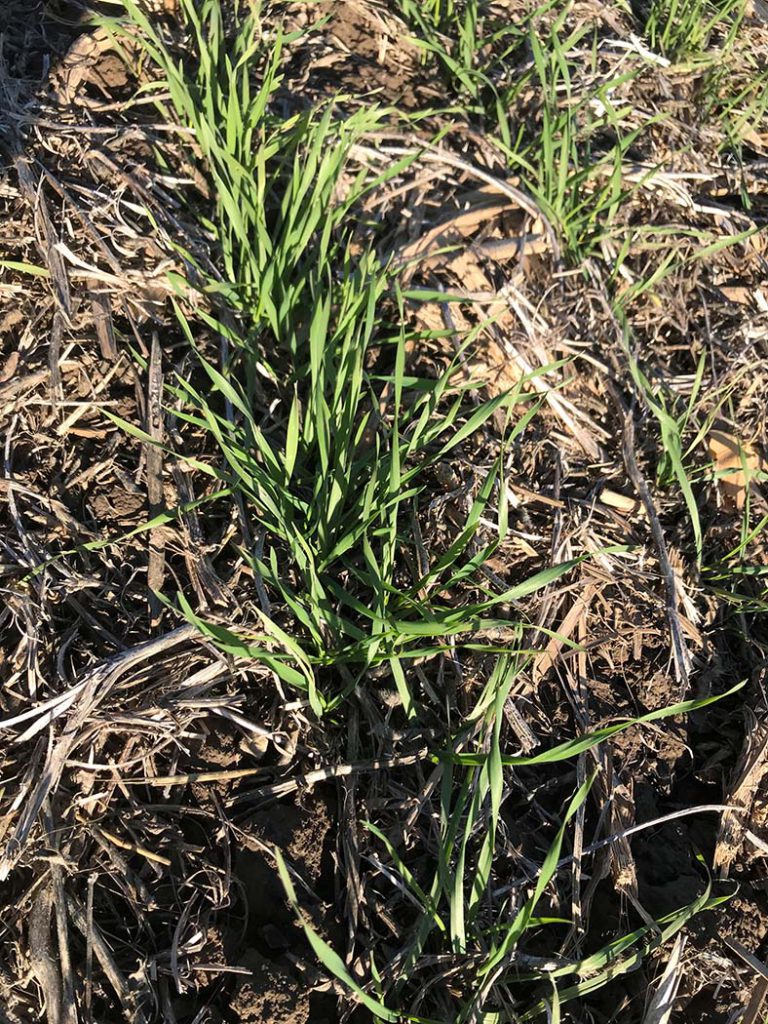

Unfortunately, some farmers are noticing on tighter ground that some wheat has been turning yellow. During these wet conditions, the ground has been saturated with water and is lacking oxygen availability. These conditions are restricting root growth and lowering root respiration. The plants yellowing is a protection technique as it’s moving nutrients to where it’s needed in the growing point. If conditions dry up, and roots are able to breath, the plants will outgrow these conditions with some set back in tiller development. If the section of the field stays wet and root growth is restricted from compaction, or water, the plants will die off in the worst areas of the field, such as low spots or compacted headlands.
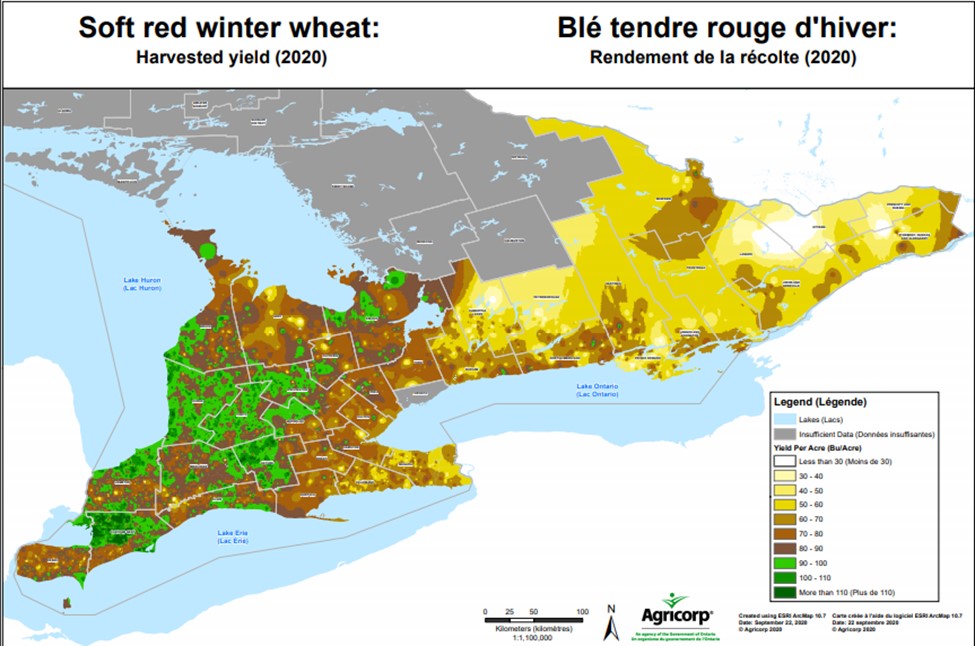
Paul Sullivan from Eastern Ontario reports that the 2020 wheat harvest experienced poor yields this year, with many crop insurance claims. The lack of rain during tillering and grain fill caused poorer plant development and poorer kernel development with many aborted florets. This resulted in yields around 60 per cent of normal, with some areas reporting 45 per cent of normal.
The May 2020 and June 2020 rainfall maps from Agricorp highlight the areas of the province that received normal and below normal rainfall. The June map particularly shows the area that received well below normal rainfall, and as the yield map indicates, resulted in far below normal yields.
Thanks to Paul Sullivan for sharing an update from Eastern Ontario.
October 23, 2020
A couple of dry days last weekend helped farmers to continue harvest and finish a good amount of soybeans acres. Rain has moved in this week damping harvest progress as farmers switch to corn harvest. Snow has made its appearance in parts of the province.
Corn
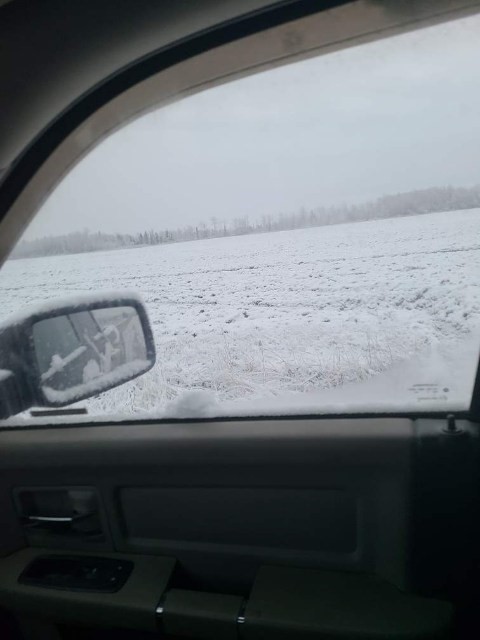
Corn harvest has defiantly begun across Ontario and has finished in some areas of Northern Ontario. In the Rainy River District, harvest is complete, they have received some snow and are now working on tillage and fertilizer application. Corn yields in the area were good, with most corn coming off dry.
In the New Liskeard area, they too have received snow. Approximately one centimetre falling this past week in New Liskeard and up to six inches in the Matheson area. There have been a few corn fields harvested, around 25per cent complete, with moistures of 25 – 30 per cent and decent yields being reported.
If you haven’t had the chance to travel to the New Liskeard area, you can find out a bit more about a small portion of Northern Ontario agriculture from a past article published in our Ontario Grain Farmer Magazine https://ontariograinfarmer.ca/2018/09/01/the-bowl/.
For the remainder of the province, as weather and corn moistures have permitted, combines have been in the fields. Moisture levels reported are anywhere from the mid-20s to low 30s. For those that are storing grain at home – ensure grain is dry, aerate grain regularly, and monitor your bins to help ensure grain condition when stored long-term. https://ontariograinfarmer.ca/2020/09/01/storing-grain-safely/
Soybeans
The New Liskeard area had a very wet fall, with worries on completing soybean harvest. But last week they received a couple good days of weather allowing harvest to really progress with 95 per cent of soybean harvest now complete.
Soybean harvest is more than 90 per cent complete across the province with some areas completely done. With the past wet week, farmers have moved away from the remaining soybean harvest and have put the corn header on to get a start on corn harvest. When drier weather returns the remaining soybeans will be harvested.
Wheat
Some areas of the province have now received fairly heavy frosts. Ideally going into winter, winter wheat should have three to four leaves and one to two tillers for maximum yield potential next year.
A special thanks to Tanja Seed for her input on the New Liskeard and area crop conditions, and Timo Brielmann for his info on the Rainy River area
October 16, 2020
Harvest is rolling on across Ontario. Cooperative weather late last week and over the weekend allowed most areas to continue or finish soybean harvest and to begin or continue corn harvest. Wheat continues to have exceptional growing weather, with moderate temperatures and rainfall.
Tar Spot has now been confirmed in a fifth county – Middlesex.
Corn
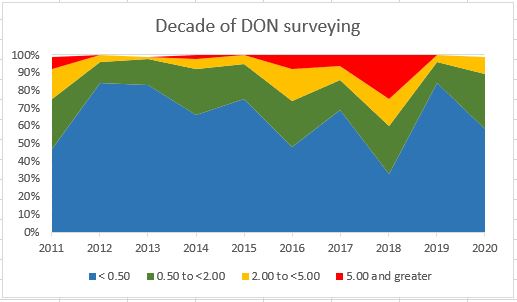
The 2020 Ontario Grain Corn Ear Mould and Deoxynivalenol (DON) Mycotoxin Survey results were released earlier this week on Field Crop News. Mycotoxins, particularly high levels of DON, can cause concern when feeding to livestock.
For more information, watch our GrainTALK webinar with Ben Rosser, corn specialist with the Ontario Ministry of Agriculture, Food and Rural Affairs (OMAFRA).
To the right is a chart, created by Grain Farmers of Ontario senior agronomist, Marty Vermey. It shows 10 years of data from DON surveys. If you compare years, 2020 is not as clean as 2012, 2013, or 2019, but more like 2014 and 2015. In general, this year’s results are good news, as overall 2020 appears to be an average year for DON, although there are some pockets where DON may be higher.
Tar spot has now been confirmed in a fifth Ontario county – Middlesex. Our GrainTALK webinar also covers some pertinent information on tar spot characteristics, impact, and considerations going forward. Information on tar spot will be made available to farmers at www.gfo.ca as it becomes available, on Field Crop News, and at the Crop Protection Network. Grain Farmers of Ontario has supported the monitoring and mapping of this disease in recent years.
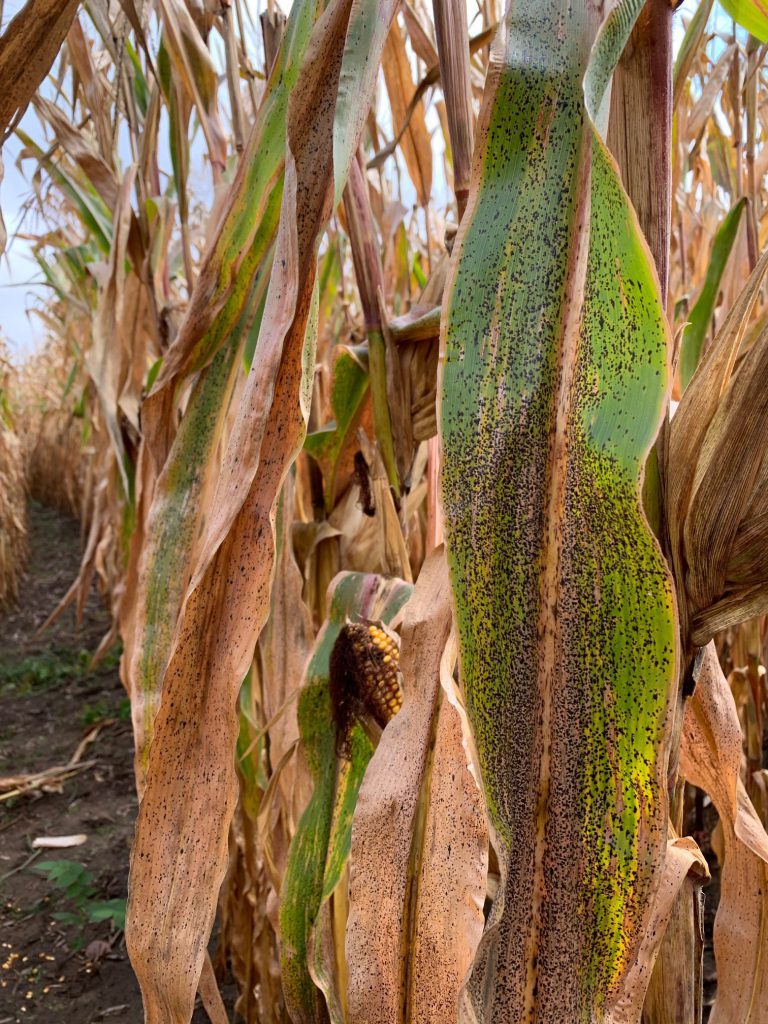
Corn harvest has continued, although with some delays as even though the past couple weeks have been warm, it is still taking some time for corn to dry down.
As noted in past updates, September brought a week of hazy skies from wildfires on the west coast, blocking solar radiation and reducing crop development. The weather was not as ideal as it seemed, as cool nights and frost on September 19 across the province also slowed down corn development as it had not matured at that time.
Looking at the Corn Heat Units (CHUs) for 2020, as of October 13, Ridgetown is roughly 150 CHU below the eight-year average, Guelph is roughly 100 CHU below the eight-year average and Kemptville is roughly 150 CHU below the eight-year average.
The cooler spring and cooler fall have stretched our corn season out longer this year. Dry down will be the key consideration for harvest and fields will vary in moisture due to planting date, hybrid selection, maturity of hybrid, field management, field stress, disease presence, and frost damage.
Overall plant heath has been excellent this year in a lot of areas which brings better yields but also prolongs maturity and keeps moisture levels up as plants are healthy longer into the fall. Healthy plants also mean healthy stalks and lodging shouldn’t be a major concern as farmers wait for the corn to dry down in the field. When snow is forecasted and the need to get the crop off before wet weather or snow, will be other considerations for the timing of corn harvest.
Soybeans
Thanksgiving weekend brought great harvest weather across the province for some to finish soybean harvest and others to continue, with the majority of soybeans across the province having been harvested by the end of this week. Yields continue to impress. Expectations were high and the crop has met expectation or exceeded in some areas.
Wheat
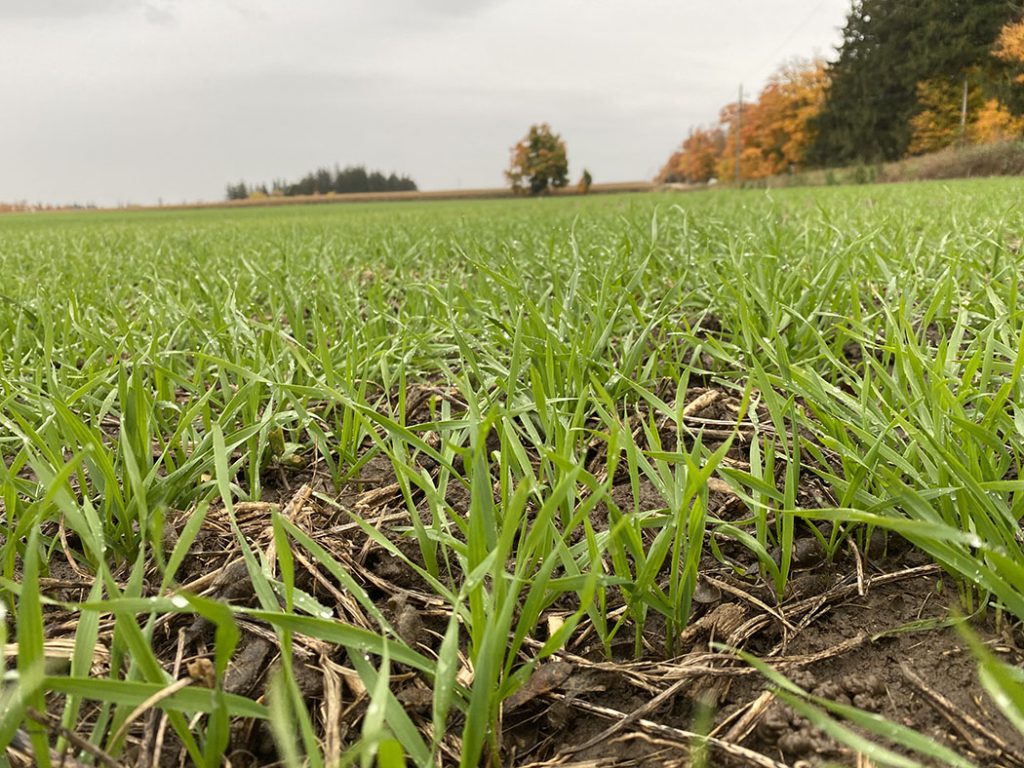
Wheat continues to have exceptional growing weather, with moderate temperatures and rainfall. The majority of the crop was planted in the last two weeks, but the early planted wheat is approaching the Z13 stage (three leaves unfolded).
A reminder that the Zadoks’ scale begins at zero for a dry seed and moves upwards, 10 for seedling growth, 20 for tillering, only primary tillers are counted.
For example, a seedling with two leaves unfolded would be Z12, a plant with the main shoot and two tillers is Z22.
Understanding cereal staging is important for various applications of herbicides, fungicides, fertilizers, and plant growth regulators.
Scouting
A brief reminder to go out and scout fields now, by walking (ideal!) or even as you are harvesting. See if there are any areas that were stressed and that you could help mitigate the problem for next year’s crop (ie drainage). See if there are any weed escapes, take note of what weeds broke through your herbicide program, perhaps you have resistant weeds you were not aware of. Also, be on the lookout for disease, such as tar spot. Use this knowledge to plan for next season.
October 9, 2020
Harvest, improving weather, and the freedoms we do have are things to be thankful for as we head into the Thanksgiving holiday weekend.
Scattered showers across the province slowed soybean harvest earlier this week, but harvest started up again mid-week. Another large chunk of the soybeans should get taken off before the next rain. Wheat seeding has progressed extremely well in areas that are still planting. Corn harvest has made some slight progress, with corn moistures lowering.
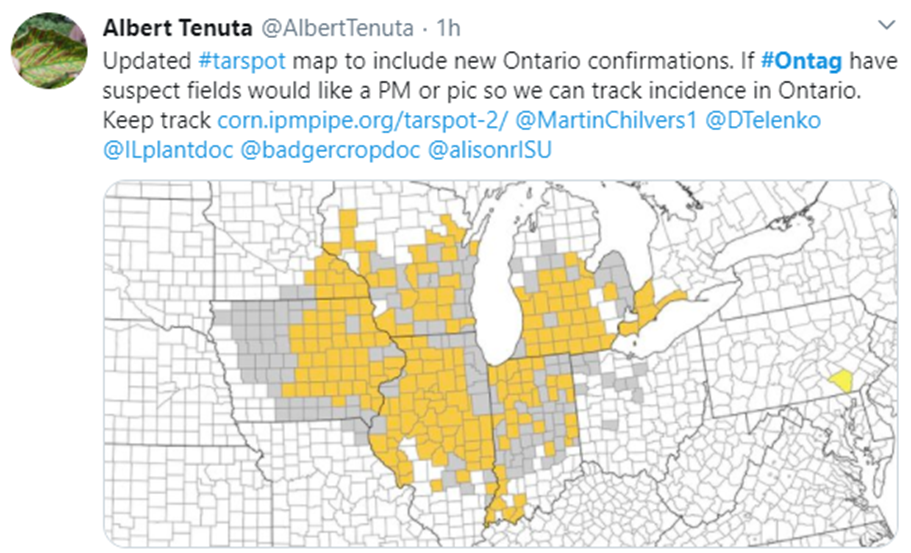
Corn
Harvest is beginning in parts of the province, as soybean harvest has been delayed due to increased soybean moistures. Corn being harvested is in the high 20s, lower 30s for moisture. Some Ontario farmers are reporting around 26 per cent on earlier maturing varieties. At this point, grain samples appear to be coming in fairly clean. In the coming week there will be more information on the DON levels in the province, as the DON survey is currently being summarized.
As previously reported, tar spot was thought to have entered Ontario. Those suspected fields have now been confirmed in the counties of Lambton, Chatham-Kent, Essex, and Elgin. If you suspect that tar spot has arrived in your field, please get in touch with Albert Tenuta, field crop pathologist from the Ontario Ministry of Agriculture, Food and Rural Affairs(OMAFRA). Also, watch for the Grain Farmers of Ontario webinar discussing tar spot to be released in the coming days.
Soybeans
Harvest was slowed or stalled off in some areas this week due to a wet period the end of last week as well as some rain moving through the province Wednesday; although some areas missed the heavy rains and were able to continue. The remainder of the week, into the weekend, looks like good harvest weather, with I’m sure lots of combines in the field. It appears that Ontario will miss any remnants from Hurricane Delta, and with luck soybean harvest should be on the home stretch shortly. In general, soybean harvest is thought to be reaching 50 to 80 per cent complete depending on the region, with good yields reported in areas of the province that received timely rains.
Cereals
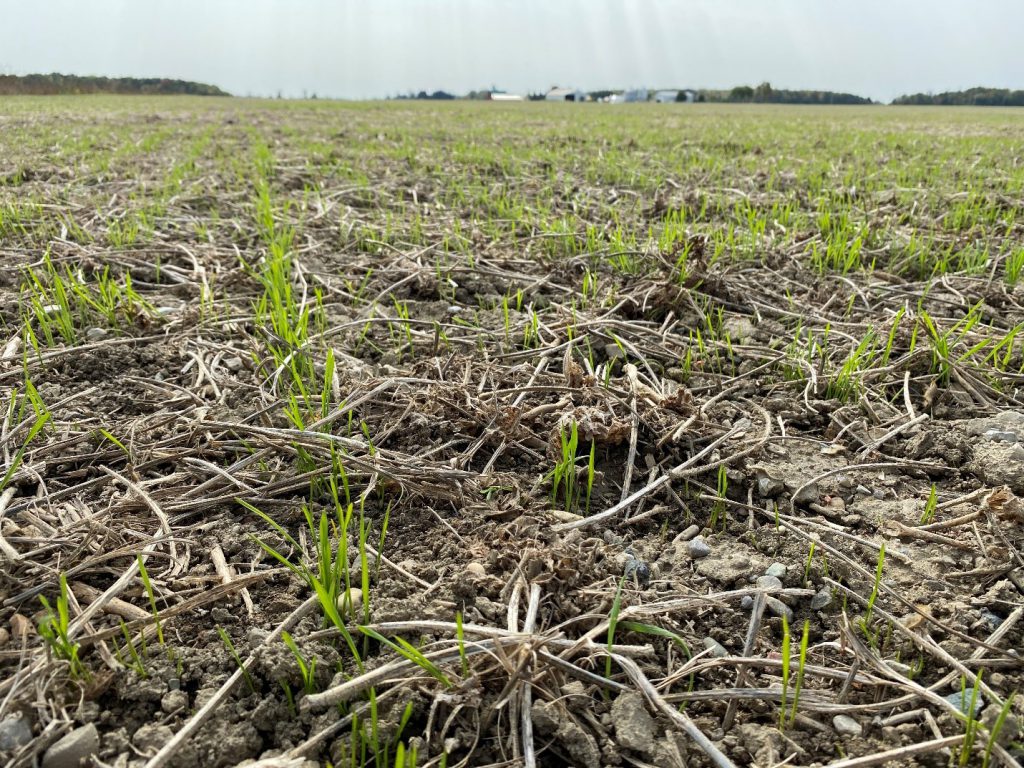
Wheat fields planted a few weeks ago have emerged and are shaping up to go into the winter season well. Winter wheat continues to be planted, although most areas have edged out of the optimum wheat planting dates, except for some parts of southwestern Ontario. A reminder of the optimum winter wheat planting dates in Ontario can be found here. https://www.gocereals.ca/OptimumPlantingDate-WinterWheat_colour_final.pdf
For areas that have passed the optimum wheat planting window, please see the Agricorp 2020 Planting Deadlines for fall seeded crops: www.agricorp.com/SiteCollectionDocuments/PID-PlantingDates-FallGandO-en.pdf.

A fair number of wheat fields harvested this past summer were then planted into a cover crop. Cover crops have had an ample amount of time for good growth heading into winter. Some recent on-farm events to note are the OSCIA’s ONFARM demonstrations this fall, showcasing various trials for cover crops across a network of 25 farm locations. Each trial examines different techniques with cover crops to help quantify the benefits in improved soil health.
Soil Fertility
A reminder to take soil samples this fall, in preparation for the coming growing season. Soil sampling is a valuable tool to measure soil nutrients so as not to under or over apply nutrient sources.
Have a safe and thankful weekend!
October 2, 2020
Scattered showers across the province have slowed soybean harvest this week. Wheat seeding has progressed extremely well in regions where soybean harvest was in full swing last week. There are reports a few early grain corn fields have been harvested.
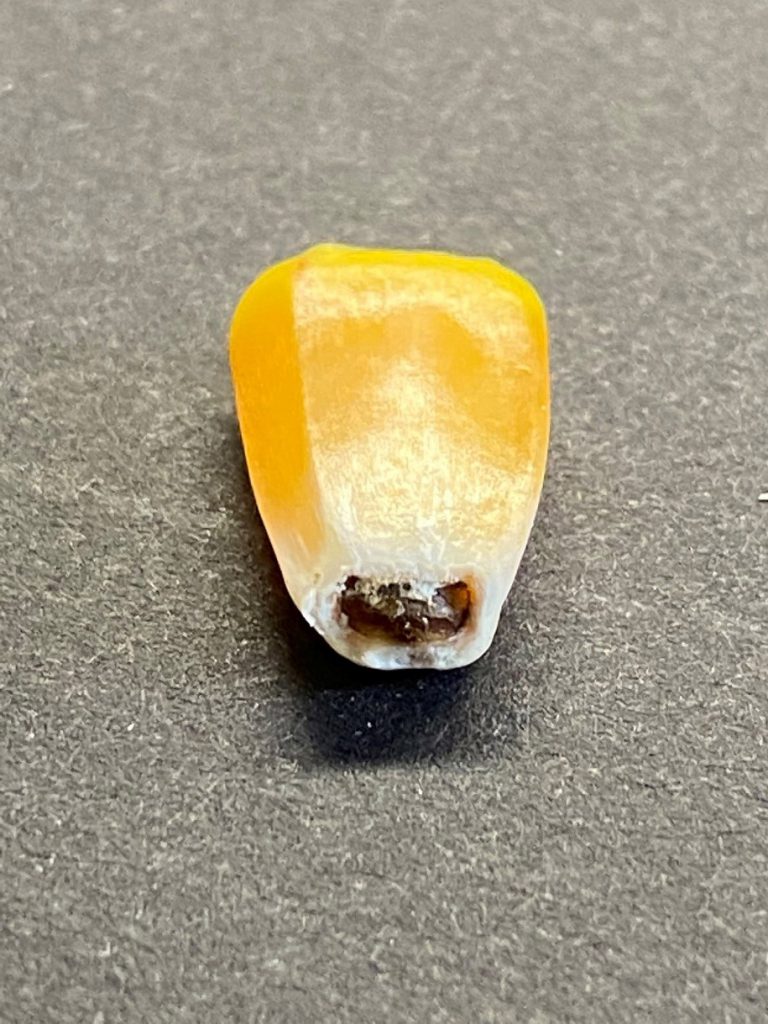
Corn
The large majority of the corn crop is now mature as can be identified by the full orange coloured kernels indicating that the milk line has disappeared and no milky starch is left in the kernel, just hard, dry starch. If you peel back the tip of the kernel, a black layer can be found on the tip of the kernel. Ever wonder what those dark brown flakes were in your corn chips or corn tortillas? It is this abscission layer (black layer) of the kernel, which acts like a one-way valve that shuts off the moisture and nutrient flow into the kernel. Immature grain on dead plants that did not reach this stage, gain and release moisture as the weather conditions change and makes harvesting harder as the kernel tends to break off the cob creating more fines in the combine.
When black layer occurs, we can expect the grain moisture to be in the 32 per cent moisture range. Grain dry down will be the next phase over the month of October. Warm, dry weather can bring grain moisture down rapidly, but cooler weather with average rain showers will slow the drying process as humidity in the air is higher. Average fall conditions in October and November can see grain moisture decrease one per cent in three days; or over 30 days, 32 per cent corn could be 22 per cent. Let’s hope we get some nice clear weather and we can shed 10 per cent moisture in 20 days. Earlier planted or early maturity corn may have already reached black layer last week and has lost lots of moisture with the warm, dry September we experienced and it could have lost up to one per cent moisture per day.
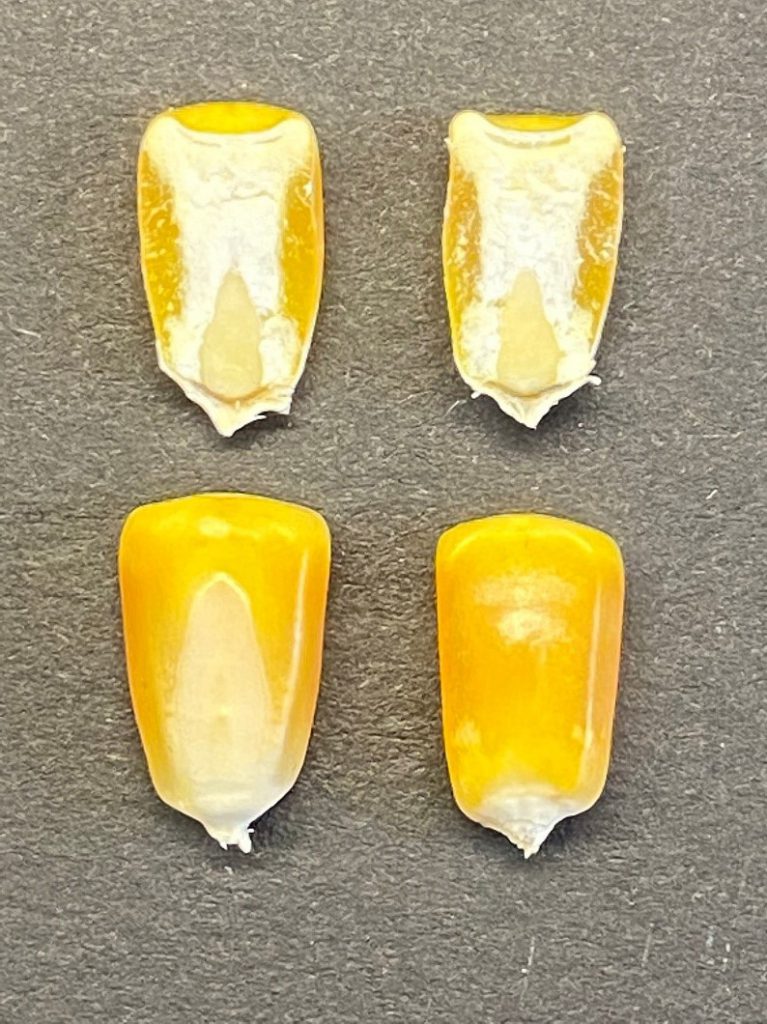
Corn hybrids differ in maturity from when they pollinate to when they reach black layer as well as how they dry down in the fall. Tight husk or open husk hybrids will dry differently so looking at a test plot with different hybrids will give you a better sense as to what can be expected at harvest. Example, the earliest flowering hybrid turns out to be the wettest in your plot. Maybe it had a longer grain fill period (flowering to black layer) or it has tight husks that are not allowing the kernels to shed moisture. These are all good things to assess, rather than assume the early flowering hybrid is the driest, which it may not be.
Corn maturity seems to be taking longer this fall. Most crop model predictions take a standard 60 days after flowering as to when the corn should be black layered, some more sophisticated ones look at high and low temperature to calculate CHUs, but we are still off this year by about a week. September was warm, but we had some cold nights, frost on September 19, and more importantly, we had a week of west coast smoke in our atmosphere that filtered out the solar radiation that the corn crop needed to drive maturity. Both the smoke and cold nights have slowed the corn crop down this fall.
Soybeans
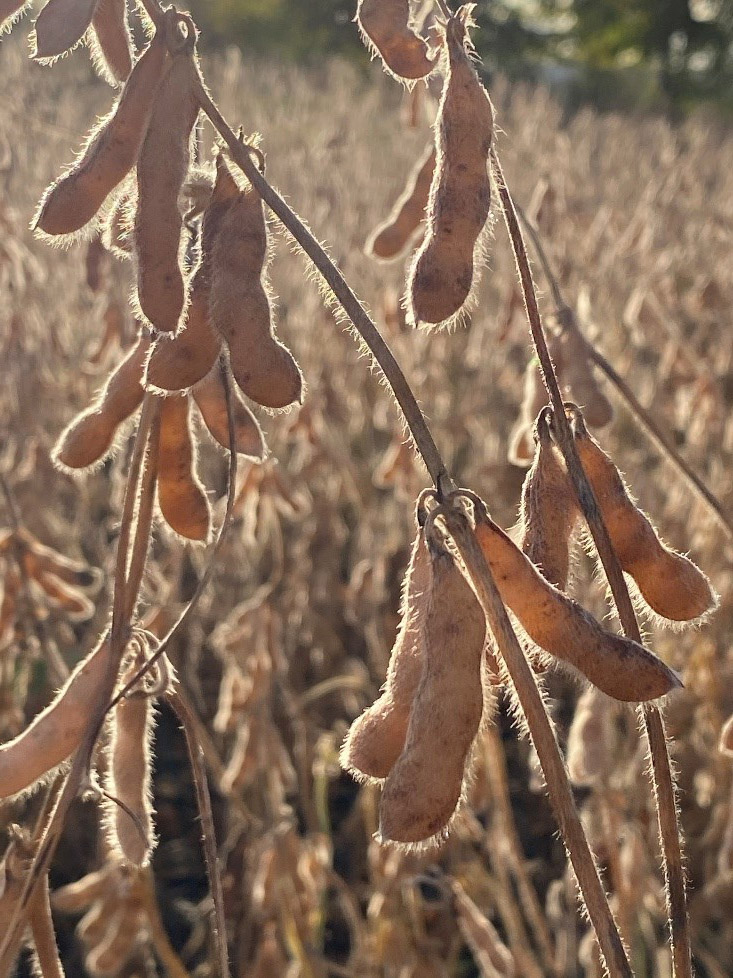
It seemed like it was full throttle on soybean harvest last week north and east of London. With reports of areas at 50 per cent to 80 per cent harvested. Bean moistures had come down quickly and harvest days were longer than normal allowing for more acres to be harvested per day.
Harvest had just begun late last week in Southwestern Ontario (west of London), as soybean maturity is a little later with longer maturity varieties being planted and later planting dates this past spring than compared to the east. Yields seem to be favourable for most farmers. Rain in August this year has helped develop the majority of the soybeans on the plant and helped to finish off the top pods. Last year the drier, late August took the top off the crop and produced smaller and aborted seed as the plant could not support all the soybeans that were pollinated due to lack of moisture. The provincial average this year will be much better than last year, and should be one of the better highs, thanks to August rains.
Cereals
Wheat planting is advancing as quickly as soybeans are being harvested this fall. Many acres have been planted before October, and rains this week will provide great germination and growth of the seeded winter wheat crop. This early planting will allow excellent plant establishment and tillering before winter freeze up. Thicker stands will lead to more head development next spring and give better yield potential for farmers. Proper nutrient management in feeding the crop and best disease protection will allow farmers the potential to maximize yields next summer.
September 25, 2020
Frost, tar spot, and soybean harvest – fall has begun.
Frost this past weekend caught many of us off guard. The forecast given last week was for a cooler weekend, with a warmer, and drier week ahead. We didn’t realize cooler meant frost! That’s how the weather works, it sometimes sneaks up on you when you are not looking. I guess, with no wind, clear skies, and dew point below 4° C it can lead to a frost event. But that doesn’t explain why it was more injurious than normal?
Tar spot on corn is presumed now to be in the province of Ontario. Samples were collected early this week that resembled tar spot and are currently at the lab for confirmation.
Soybean harvest has started strong this week with seed moistures dropping rapidly as we are in a dry and warm period during harvest.
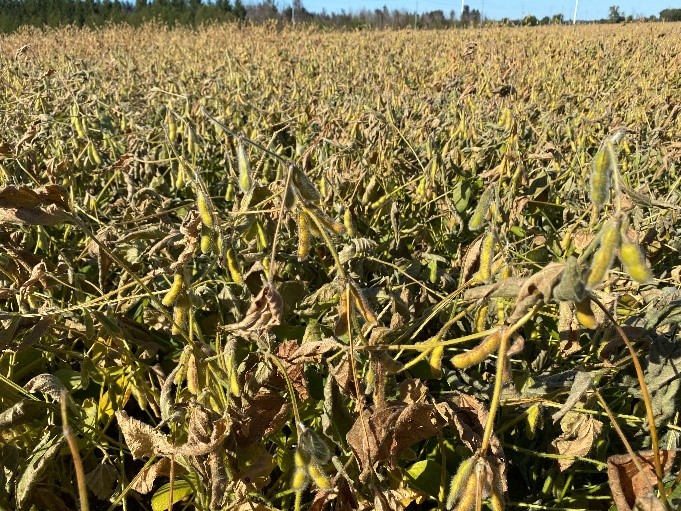
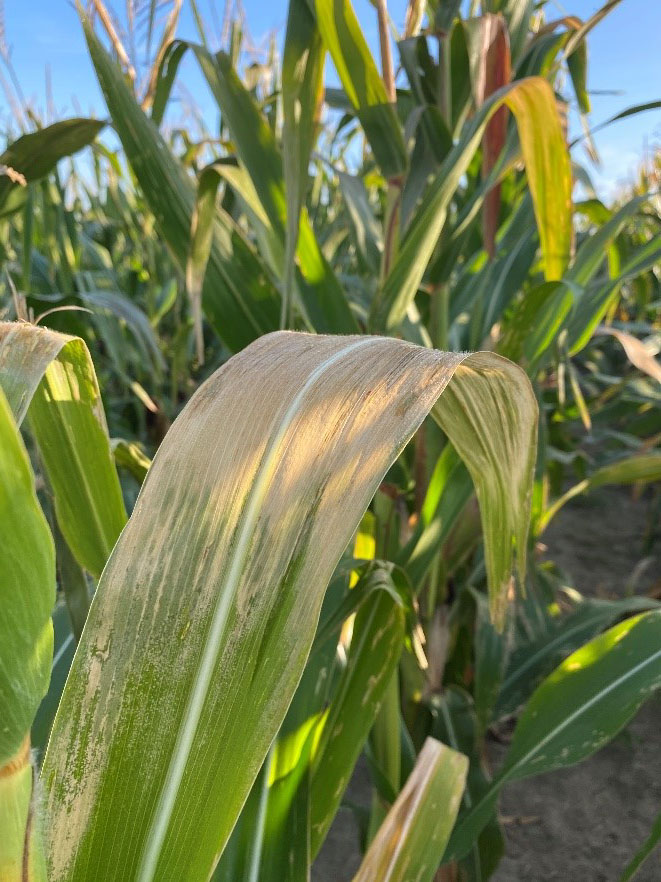
Frost
The forecast for Friday night, September 18, was for a low of 6° C,, but we awoke with 4° C to 1° C on the thermometer depending on who you talk too and when they woke up. The Environment Canada website recorded -0.2° C for our local weather station and most around the province ranged from 3.3° C in Windsor to -3.3° C in Peterborough.
What happened? Well frost occurs when water vapour in the air forms as ice on a surface. As the surface looses heat energy over the night to the cooler air, the cool surface in turns takes heat out of the water vapour causing the water vapour to form an ice crystal on the surface. The surface could be the ground or the crops top surface, or the roof of buildings. Our temperature measurements are officially taken at 1.5 metres from the ground, so colder air will settle below what we have measured, a recorded -0.2° C temperature Saturday morning may mean that the air below the thermometer was much colder. Also, many farmers may have thermometers by the kitchen window. The house will continue to radiate heat through the night and the air temperature beside the house is not the same as just above the ground. So, it’s colder than your think at the surface of the crop.
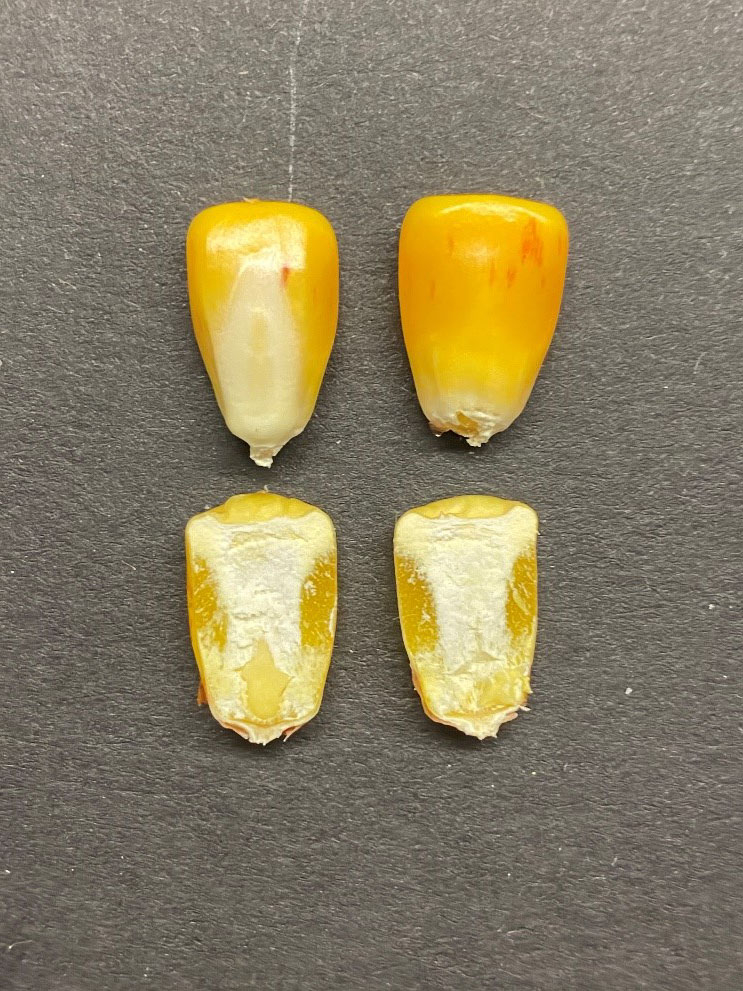
But still, why so much damage? I’ve had 0° C before and no damage. Maybe the air was more still this time, or there was more moisture in the air that created greater ice crystals, and maybe the bright sun on Saturday morning reflecting on the ice crystals intensified the solar radiation on the leaf surface (magnifying glass effect) creating damage to the leaf. At least in the southwest the corn leaves look like sun scorch damage, while further north the leaves had that dark green/grayish water soak look to them like the leaf cells were frozen.
Corn
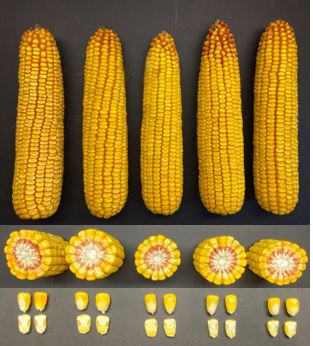
The Ontario corn crop is rapidly trying to finish the last little bit of kernel fill as the frost events have started the plant shut down. As the plants will be limited to any more sugar production, the plants will need to rely on translocating the current sugars from the leaves and stalk to help finish the kernel starch pack. We can expect that the lack of sugar in the stalk will weaken the stalk strength when we get further into the fall. Keeping an eye on stalk deterioration will be important as you pick which fields to harvest first or which ones to leave for later.
The frosted corn will also have a fast moisture dry down in the whole plant as silage producers are rushing to finish harvest before the plant becomes too dry. In turn, with dry weather conditions, good grain drying will also occur as no moisture will be taken up by the plant as its shutting down.
Tar spot was identified in Ontario for the first time on September 21, 2020 in Chatham-Kent and Lambton counties. Samples from Ridgetown have been confirmed in the lab that it is tar spot and the Lambton samples are in the lab waiting confirmation. Since tar spot has been a fungal disease in the U.S. midwest since 2015, it was all but a matter of time until it the spores would blow into Ontario and infect some of our corn crop. The appearance late this fall at a very low level will not cause any yield or economic harm today. But it does pose the threat for future years since the spore are now here and will over winter in the residue. The disease pressure will build in the future under ideal growing conditions of cool and moist weather. Early infection causes the greatest yield damage and will be another disease we will have to keep an eye on while doing our route scouting in the spring and summer. The good news is we have had several years of learning with the infection in the U.S. Midwest and through the cooperative work Albert Tenuta (OMAFRA) has done with the Crop Protection Network https://cropprotectionnetwork.org/ with funding from Grain Farmers of Ontario, we are prepared to have BMP’s and potential fungicide solutions that can help manage this disease and prevent the major yield losses many U.S. growers faced in the first years of the outbreak state side.
Soybeans
Harvest has begun across the province. With the dry weather this past week and a half, farmers have experienced rapid drying of soybeans and moistures have fallen from ideal to way too low in a matter of hours. Reports have come in that harvesting at 13.5% (ideal) one day and by the third day fields are down to 8%. It seems simple to just harvest on the day soybeans are ideal, but unfortunately there is not enough hours in the day or machines available to do that. Usually when the seed first dries during dry weather, there is the concern that plant stems may still be wet/green which makes for hard cutting and wrapping of the plants on the header reel. When the plant is dead and dry, than the soybeans are too dry under these low humidity conditions. Usually a rain before harvest just before the plants mature will help ripen the plants and seed more uniformly and keep soybeans at the right moisture. Harvesting soybeans when the seed is too dry brings up the concerns that the seed can crack, pods at the head shatter, and field losses occur. More importantly, seed is traded at 13%, and shipping seed at 8% is giving slightly more than 5% of the volume away, or at $12 per bushel it’s like only getting $11.40 per bushel. The processing of dry soybeans is also more difficult and in the case of seed soybeans, seed treatment applied to the seed can be sucked into the seed and can reduce the germination of the seed. Its all bad at that low of moisture. Rain is forecasted for early next week and for those fields way to dry, it maybe an opportunity for them to gain some moisture and allow farmers to harvest soybeans at a better moisture level.
Cereals
Winter wheat is starting to be planted right behind the soybean harvest this fall. If planting much earlier than your optimum planting date, backing off on the population is advised as good plant growth and tillering can be expected with the warmer fall that is predicted. If planting at ideal dates, population should be at normal populations and later planting dates will require higher populations in order to compensate for less plant growth and fewer tillers. Planting populations range from 1.2 million to 1.8 million seeds per acre depending on planting time, soil type, and management. Always check your seed source and adjust population depending on the tested germination. If planting by pounds per acre, as that’s how the drill is set up, make sure to check seed size and adjust how many pounds you are seeding. Based on variety and environment where the seed was grown, seed lots can vary up to 3,000 seeds per pound. If seeding 103 pounds to the acre this could mean close to 400,000 seeds per acre difference. Which in turn could mean a too thin stand or a way too thick stand that may get more disease and be more lodge prone. Adjust the planter based on what you are seeding.


























